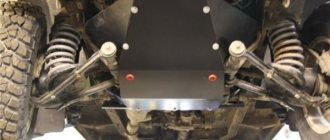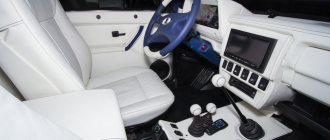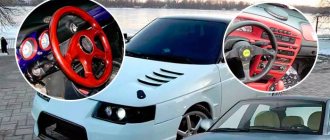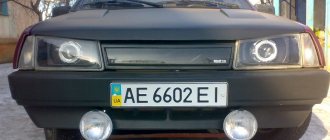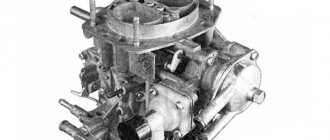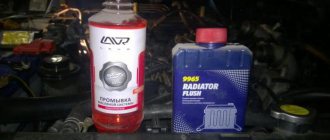VAZ 2109 (popularly called “nine”) is a Soviet front-wheel drive vehicle of group II small class in a hatchback body. The model was developed and mass-produced at the Volzhsky Automobile Plant from 1987-2004.
From 2004, cars (VAZ-21093) until the end of 2011 were assembled from vehicle kits at the Ukrainian enterprise ZAZ. This vehicle is also a five-door version of the VAZ-2108 in the Lada Sputnik model division. You can still buy this car on the used car market today. The entire Lada model range.
Car history
Towards the end of the 1980s, AVTOVAZ decided to fill the empty niche of comfortable and versatile family models with the VAZ-2109 car. The fact that the debut domestic mass-produced front-wheel drive car appeared at the Volga Automobile Plant was a significant event not only for the Volga residents, but also for the entire Soviet automobile industry.
It’s a little symbolic, but the start of production of the G8 coincided with a significant event that was celebrated in the fall of 1984 - the 60th anniversary of the automobile industry of the Union of Soviet Socialist Republics. After two years, the original assembly line of the car plant in Togliatti produced a pilot batch of 159 Nine models.
The new version of the “chisel” inherited all the technical innovations from the older model and was able to instantly gain the respect of car lovers. Among all the points, the most important was the “rational” number of doors. However, despite this, a three-door version entered mass production. The logical question arises, why?
Because in a state where personal transport was considered a luxury, and happy car owners felt the transport difficulties of their relatives and friends, the standard 3-volume sedan version was more suitable to the needs of drivers. For a long time, all Soviet mass-produced cars were produced in just such a body.
More productive station wagons, which were produced in small quantities, began to be sold only towards the end of the 1960s, and they were considered in great short supply. There was not a word about other versions of the body: directors of automobile enterprises did not even risk conducting experiments, objectively believing that these programs would not be positively received “at the top.”
But in the case of the G8, everything turned out in the opposite order. At the end of the 1970s, all of Europe was literally overwhelmed by the fashion for hatchbacks. The leaders of the Tolyatti automobile plant, wanting to comply with modern trends, during the design of the new model series, decided to introduce into it, in addition to the standard sedan, 3- and 5-door hatchbacks that were fundamentally fresh for Soviet industrial turnover.
The entry into the foreign market of a new car, designed in accordance with the standards of global trends, was supposed to strengthen VAZ's export positions. The Ministry of Automotive Industry cooled down the ardor of the engineers from Tolyatti a little, calculating the impossibility of financing the production of all 3 versions for assembly line assembly.
In reality, it was possible to free only one line of the factory conveyor for the assembly of 2 standardized modifications. As it turned out, the role of those “lucky ones” was a hatchback, which had a lot of common body elements. As the base version, they decided to choose a cheaper three-door car, and a couple of years later, a five-door car “came to the rescue.”
The sedan version (VAZ-21099) was introduced into mass production only at the end of 1990. Although this delay in a sense benefited the enterprise itself, since with the appearance of the sedan there would have been intense competition with the hatchback version, which was in no way included in the plans of the management of the Volzhsky Automobile Plant.
Determining the scope of work
In order to decide what materials should be used when carrying out soundproofing work, you first need to draw up a work plan. As a rule, sound insulation modifications are carried out to achieve the following goals:
1. To get rid of squeaks in the cabin. 2. To increase the comfort of your stay. 3. To increase the efficiency of installed acoustics.
When doing the work yourself, when there are certain budget restrictions, you should not rush to finish the job by using less material. In this case, the work can be divided into several main stages: to begin with, you can insulate the doors and trunk, and after improving your skills, move on to the floor, ceiling or side walls of the body. When considering what materials are needed to insulate the interior, we note vibroplast and splen. The combination of these materials can significantly increase the efficiency of sound insulation work. Other materials can be used if possible - if there is enough money, then you can purchase other materials.
Appearance
From the outside, the VAZ-2109 is an evolution of the Soviet car. Here you can notice the transition to rectangular body lines, which are clearly distinguished by the bow headlights, which are shaped like a trapezoid, as well as a flat-shaped radiator grille and a slightly inclined hood. It was decided to place the turn signal lights on the long front fenders.
After some time, hydraulic headlight range control began to be installed on all “nines”, and some vehicles had a brush headlight cleaner. In 1989, the debut restyling of the “nine” exterior took place, which consisted of a transition from small front wings to longer ones. The most dubious component in the exterior of the G8 and VAZ-2109 was the so-called nasal mask.
It was a fairly complex type of body part, which was adjacent to the hood and wings installed in front. The combined mask area had a beak that protruded forward of the radiator trim. Block headlights were installed on the sides of this unusual structure. Such a pile of elements reduced the already slight elegance of the Soviet car, and the clear lines connecting the cladding to the wings looked unpleasant.
We decided to use only a solid wing, without any “tricks,” which improved the appearance of the VAZ 2109. After this, they installed a new grille, which had two longitudinal stripes in a large frame. After some time, they began to use a new version, consisting of 3 massive stripes, devoid of any frame.
VAZ-2109 with an updated radiator grille
The side part has the same straight lines of doors and roof, wheel arches and average ground clearance. “Nine” is very similar to its predecessor, the VAZ-2108, which was nicknamed “chisel”. The Soviet hatchback has the same nose shape. Unusually large doors and a thick central pillar add “sporty features” to the model.
On the “nine”, the width of the doors installed in front was reduced from 1,264 to 1,025 millimeters. Thanks to this, the design team was able to incorporate rear doors into the side of the body, the width of which is 885 millimeters. The rectangular rear lights are limited by the line of the luggage compartment lid, which also has a sharp transition at an angle to the roof.
The fifth door received a rear window with a wiper, and the bumpers, along with the side skirts, were made of black plastic (there is a similar bumper in front). The design of the VAZ 2109 has a certain swiftness of lines, but it is very far from a sports car.
Here the developers placed great emphasis on the more practical aspects of the vehicle. When 1987 arrived, the new model mastered the production of plastic gas tanks, which were much lighter and easier to assemble than others. VAZ-2108 and VAZ-2109 already had gas tanks made of steel and plastic.
It is worth admitting that after a while they decided to abandon the production of plastic tanks, as there were problems with the permeability of gasoline vapors.
Branches of individualization
The process of giving the salon an individual, unique appearance that will fully satisfy the owner’s needs can be divided into three branches:
- Replacement of standard elements with improved ones;
- Installation of additional components for the interior;
- Upholstery of the internal space with various materials.
Modernization is a useful event for the domestic nine. Even owners of cars in the Luxury configuration, where there are soft door panels and velor on the seats, complain about the poor build quality. What can we say about the standard gray interior.
Interior
The interior decoration of the VAZ is reminiscent of the minimalism of the 1980s. The instrument panel and dashboard create an almost right angle. There are only 3 types of panels: “low”, “high” and “European”. If we talk about the quality of the plastic used as finishing, then it is far from ideal.
Of course, by installing plastic in the interior of the Nine, it was possible to reduce the weight of the car, but on the other hand, it deprived VAZ cars of that touch of luxury that the Zhiguli of the classic division is remembered for. If you look at it differently, the ergonomic level is not bad, so you don’t have to be distracted from driving the vehicle on the road.
This was partly achieved through the compact arrangement of controls. Inside the steering wheel there is one curved cross member with a horn button. Airbags are not provided by the factory. In general, the interior of the VAZ-2109 is purely practical with claims to the level of comfort.
Despite the laconic “low” instrument panel, it is quite comfortable. Although many liked the high panel 2109. The seats installed in front received headrests. In addition, the front seats have upper seat belt attachment points that are height adjustable.
The elastic seats provide good body support. But a tall driver will lack the choice of adjusting his seat in the longitudinal plane. The rear sofa, although designed for three passengers, can only accommodate two people comfortably.
Do not forget that their height should be no more than 175 cm. The luggage compartment volume of the Soviet hatchback is quite modest 270 liters of usable space (the more practical platform version already received 400 liters).
Interior noise insulation
If you are planning to carry out serious tuning of a VAZ 2109 car, first of all you should think about sound insulation, because it is not for nothing that the nine was called “rattle”. This is partly due to the not very good quality of the plastic parts, as well as the assembly itself. Before getting down to business, it’s worth deciding on the material, since the result, complexity of the work, as well as financial costs will depend on this.
First you need to disassemble the entire interior: remove the seats, trims, and instrument panel. Actually, as a result, bare metal should remain in the cabin. By the way, since you’ve already gotten to it, check all the plugs and possible problem or rusty areas. Make repairs where necessary.
We begin pasting the interior from the engine shield, and if necessary, apply sound insulation in two layers. At the end of the work, do not forget to restore the ventilation holes.
Important. Before gluing, clean the metal with a rag soaked in acetone, alcohol or another degreaser. There is no point in treating the entire interior at once, since during the work the surface will get dirty, so the surface is degreased immediately before pasting.
Technical characteristics of VAZ 2109
Engine
In the role of motors, domestic engineers used various power plants with different volumes and power. The very first Soviet-made models came with a 1.1-liter engine.
The basic version of the “nine” was equipped with a 4-stroke, eight-valve, four-cylinder power unit of the “eight”, the displacement of which was 1,295 cubic centimeters. This “engine” developed 64 horsepower at 5,600 rpm. Peak torque (94 Nm) reached after 3,400 rpm.
The speed limit was 148 kilometers per hour. The first hundred was reached in 16 seconds. Such a modest engine consumed about 8.7 liters per hundred kilometers in city mode and 5.7 liters outside the city.
Option 21093 already has a carburetor engine 21083. It has a volume of 1,499 cubic centimeters. Maximum power of 69 “horses” is achieved after reaching 5,600 rpm. The maximum torque is 106.4 Nm already at 3,500 rpm. The Soviet hatchback can accelerate to 155 kilometers per hour, and the first hundred is reached in 15 seconds.
It is logical to conclude that as power increases, gasoline consumption also increases. So, in the city this figure remains at 8.6 liters per hundred kilometers, and on the highway it drops to 5.9 liters per 100 kilometers. The VAZ 2109 carburetor was called “Solex” and was a new, more economical model.
The most compact is considered to be the 1.1-liter engine, developing only 54 “horses”, which were available at 5,600 rpm. Maximum torque of 79 Nm is available at 3,600 rpm. The maximum speed does not exceed 155 kilometers per hour, and fuel consumption in combined mode is about 6.7 liters per 100 kilometers.
In addition, later they began to produce the VAZ 2109 engine with an injector. It received the index 211180 and was installed in the VAZ-21093i and 1.5 liter volume. This power unit is capable of producing 72 horsepower, available at 5,600 rpm.
Peak torque of 118 Nm is available at 2,800 rpm. For every 100 kilometers, the fuel consumption of the VAZ 2109 is 8.0 liters in the city and 5.8 liters on the highway.
In the injection version of the engine, injectors very often fail, but you can repair them yourself or have them repaired by specialists. This video explains well how to clean and rinse the injectors yourself.
Transmission
The gearbox for the hatchback initially came with four speeds, but since 1989, the engineering staff decided to introduce a five-speed manual transmission. This transmission has a single-plate simple clutch, a cylindrical final drive, a bevel differential and drive shafts with CV joints.
There is also an integrated center spring and cable drive. The VAZ 2109 gearbox is not very complicated, so some even undertake to repair it on their own.
The design of the Soviet front-wheel drive hatchback has an interesting feature. In order to engage reverse gear, move the gearshift lever all the way to the left and forward. Almost the same principle applies to turning on the first speed.
Chassis
At the front, they decided to install a fully independent McPherson-type suspension, which is also called a “floating spark plug.” At the rear they installed a semi-independent suspension with a transverse beam that works on torsion.
In its structure, such a beam is similar to numerous front-wheel drive cars of past years. Hydraulic shock absorbers, cylindrical springs, as well as lower wishbones with braces and a stabilizer bar are used.
As a braking device for a front-wheel drive car, disc brakes with movable calipers in front and drum mechanisms in the rear are used. The distance between the disc and the pad is adjusted automatically. The brake drive of the machine is represented by the hydraulic method.
Safety
The dashboard takes impacts tightly. The controls, along with the headrests and other elements, were made of soft plastic. The factory provided sun visors, so as not to blind the driver, which were covered with cladding. Additional sun protection is provided by easily adjusting the placement of the interior mirror.
The plant workers provided a system of mutually moving elements that absorb the impact force, combined with a carriage that moves to one side, which, using an adjustable delay, reduces the collision energy with the steering wheel. The aspherical concave external mirror increases the viewing range.
Estimating the distance to the car following behind will only be symbolic, since there is a slight distortion. The designers of the VAZ 2109 provided seat belts not only in the front seats, but also for those sitting in the rear. Such an element can save more than one life!
The car received three-point seat belts, with an automatically winding device and a locking device, which provides full independence of activity at a calm speed mode, while at the same time clasping the torso tightly and with tension.
During strong acceleration or deflection of the machine, the belt is quickly locked in all directions. This option is not tested by special sudden movements of the body.
Tuning the dashboard lighting
To upgrade the dashboard lighting in the VAZ-2109, it is necessary to replace the standard lamps with LED ones. In this case, you will need to make a small modification of the scales yourself.
What you need to tune the backlight:
- modern dial sticker kit;
- overlay with scales;
- UV lamp;
- fluorescent marker;
- car paint.
Having provided all the necessary parts and tools, you can begin to work. After dismantling the dashboard, remove the original insert with scales. Remove all arrows from it and set aside for later use. If necessary, you will have to make additional holes in the new scales.
The second stage will be to dismantle the original instrument panel lighting. Remove the board with the lamps and carefully remove them. In their place, install new neon or LED lamps. A protective plastic cover must be placed on top. During operation, it is necessary to control the polarity, which is displayed on the backlight control unit, so as not to mix up the wires and not disrupt operation.
After completing the main work, you can begin to refine the scales. Using a fluorescent marker, highlight all the numbers on the newly purchased overlays to make them clearer.
The final stage of tuning will be the following combination: install the board with lamps, on top - your overlays with scales. When doing this work, be careful not to damage the locks of the windshield wiper blades.
Price and options
The “nine” did not have a special level of comfort, so there is simply nothing to describe to a greater extent. Even then, it was in many ways superior to foreign cars. But the domestic hatchback was distinguished by its maintainability and the presence of the necessary parts.
The steering wheel did not have a hydraulic booster, so you had to physically work hard. There was a standard heater, a simple steering wheel and standard seats with seat belts installed.
It was possible to adjust the external mirrors from the interior using a mechanical lever. Today, the VAZ 2109 can only be purchased on the secondary market. Usually the price tag for this car is low, so you can buy a car on the go from 60,000 rubles.
Content
It is impossible to imagine changing the interior of a car without upgrading the instrument panel, since it is an important part of every car. Many owners of the car in question decide to tune the instrument panel of the VAZ 2109, since by modern standards it is very outdated and not attractive.
In the manufacture of this element of the car interior, the manufacturer used a material that can absorb vibration. When considering the instrument panel, we note that it consists of a special overlay and the panel itself.
Owner reviews
Despite the rather outdated model, appearance and low dynamic performance, as well as the low level of comfort, many motorists speak quite well about the “chisel”. I am pleased with the simplicity and inexpensive maintenance. Parts can be purchased for the best possible price, and also at a flea market. You can repair it yourself. The car is ideal for tuning.
The unpretentiousness of the car is known to many. Positive reviews include fairly acceptable fuel consumption, at the level of 8-10 liters in the combined cycle. Summer residents can especially be pleased with the good ground clearance, which allows them to confidently drive over uneven surfaces and not be afraid of bumpy roads.
It’s bad that there is no hydraulic power steering, so you have to make physical efforts to control the car, especially while standing still. Inside, people can comfortably fit only in the first row of seats. For the second row there is not much free space left in the legs and above the head. It’s not very comfortable for the three of us to sit, and the transmission tunnel running in the center clearly causes discomfort.
According to reviews from VAZ 2109 owners, the hatchback’s heater works strangely; at first the interior is filled with cold air, and only then warm air begins to flow in. The quality of the interior is very mediocre, the plastic is cheap, you can hear crickets everywhere, and there are noticeable large gaps between the panels. The power unit very often lacks power, so you have to spin the engine up to 4,000 rpm.
If desired, it would be possible to install air conditioning, but the engine is very weak, so the question disappears. Safety is also far from ideal, so if there is a serious accident, at best you can get away with injuries. Only recently, domestic cars began to be equipped with many systems that ensure safety, but this, of course, did not affect the VAZ 2109 in any way.
What tools are needed to get the job done?
If you only have certain tools, you can carry out the work of insulating the car interior.
These include:
1. A heat gun is a must-have tool that is needed in order to heat the insulating material for its installation. Certain insulating materials require heating before use. Exposure to high temperature causes a significant increase in the plasticity of the material. Exposure to warm air can change the shape of the insulating plates, which will allow them to fit all the curves of the body. It is worth paying attention to the fact that a construction hair dryer is significantly different from ordinary ones. This is due to the blowing power indicator, the maximum temperature of the supplied air and many other points. It is with a heat gun that serious problems can arise.
2. When working, you will need measuring tools. In order for the thermal insulation to be sufficiently effective, the formation of a large number of different joints should be avoided. This can only be achieved by precisely changing the dimensions and shape of the insulating material, which can only be achieved by using a measuring tool.
3. Quite a lot of work will need to be done to change the size and shape of the insulating material used. To do this, you need to use various cutting tools: a knife, an angle grinder, scissors, and so on. It is quite important to cut the material efficiently, without compromising the integrity of the edge.
4. Many modern insulating materials have an adhesive base that is activated when heated. However, some can only be attached using staples.
You may also need other improvised construction tools, for example, pliers and a rubber hammer.
Advantages and disadvantages
Pros of the car
- Inexpensive Soviet-made car;
- Front-wheel drive can certainly be considered an advantage;
- Acceptable ride height;
- Good dynamics, high speed, pleasant handling and sufficient stability on different surfaces;
- Heating and ventilation cope well with their tasks and supply air to several points at once, which improves the uniform distribution of thermal air throughout the cabin;
- Acceptable fuel consumption;
- Ideal for tuning;
- Availability of spare parts and good maintainability.
Cons of the car
- Corrosion of metal;
- The appearance is clearly not for everyone;
- A small resource of some details;
- Mediocre sound insulation of the cabin;
- Low equipment;
- There is very little free space, especially for rear passengers;
- Small luggage compartment;
- Poor maneuverability;
- Poor quality interior;
- Low level of security;
- The power unit clearly lacks power.
Insulation work
The first thing you should immediately pay attention to is that strong noise while driving and the appearance of vibration significantly reduce the comfort of staying in the vehicle interior. In other words, any modifications to the interior will not lead to the desired result, since constant squeaks, hums, and howls will cause quite a lot of unpleasant sensations.
Modern insulating materials can significantly increase comfort in the cabin. At the same time, we note that after high-quality work, the result will be practically obvious. All work can be divided into the following stages:
- Dismantling interior elements and upholstery. VAZ 2108 interior tuning can only be done by dismantling all the trim and panels down to the base.
- The next step is to purchase the necessary material. Note that there are quite a lot of different insulating materials, each with its own special performance properties.
- The process of pasting the interior can be divided into several main stages. As a rule, separate insulation is carried out for the interior, luggage compartment, and the plate that separates the engine compartment. You should also highlight the insulation of doors and other structural elements of the car.
- After the entire body has been covered, you can begin the interior assembly stage.
As a rule, it takes about several days to complete the work in question. In this case, there should not be any special problems in selecting the necessary tools and materials.
Technical characteristics of VAZ 2108
| Engine | 1.3l, 8-cl. | 1.5l, 8-cl. | 1.5l, 8-cl. |
| Weight in running order, kg | 930 | 900 | 920 |
| Gross vehicle weight, kg | 1305 | 1325 | 1345 |
| Permissible total weight of a towed trailer with brakes, kg | 900 | 900 | 900 |
| Ground clearance, mm | 160 | 160 | 160 |
| Trunk volume min/max, l | 330/640 | 330/640 | 330/640 |
Let's sum it up
After getting acquainted with the Soviet hatchback VAZ 2109, conflicting feelings remain. On the one hand, this is a car that boldly stepped into the future, because previously there were only rear-wheel drive models, but on the other, the quality of the Soviet automobile industry is lame in many respects and is significantly inferior to foreign cars.
However, among other things, the car is ideal for beginners who are just learning to drive, since the car can be purchased for a “mundane” price tag. On top of that, hatchback parts can be found everywhere and they are not that expensive, which is a definite plus. You can carry out repairs yourself in your garage, which also simplifies a lot.
The car looks quite controversial, so it has both supporters and opponents of its exterior. It is clear that there is not much free space inside, especially for rear passengers, and the luggage compartment volume clearly leaves room for improvement.
Also, the quality of the materials and plastic used for finishing is very poor, “crickets” can be heard everywhere and gaps between the panels are visible. The seats themselves are not the most comfortable, so during long trips you may feel tired. Based on crash tests, the hatchback is a dangerous car.
The car clearly lacks power, so you almost always have to turn off the engine of the VAZ 2109. But do not forget that the car is many years old and at its age it was very popular in the Soviet Union, as there were queues for it.
Yes, the model did not receive air conditioning, hydraulic power steering, etc., but tuning enthusiasts can upgrade and create a car to suit their preferences for fairly reasonable money, making the car a unique vehicle. “Chisel” will forever remain in the memory and hearts of those who owned it, despite frequent breakdowns and low levels of comfort.
We advise you to read the article: History of AvtoVAZ - LADA cars
Complex instrument panel upgrade
You can make the panel device even more unusual using another method. To do this you will need the following:
- Soldering iron. When choosing, you should give preference to a soldering iron with a small tip, since many works involve microcircuits. A small tip allows you to perform soldering with great care and precision.
- Panel-scale.
- Numbers that show through inside.
- An ultraviolet lamp that is powered by a 12 Volt network.
- Paint or bright marker. When exposed to ultraviolet light, the color of the surface will change.
- An ordinary light bulb with a socket.
Once everything you need has been found, you can begin to do the work. First, the plastic is dismantled, and then the dashboard. When disassembling the dashboard, do not forget about dismantling the plastic that is located around the glass. New stakes often do not have the necessary holes, so we make them ourselves. The holes for the arrows are also being enlarged, since otherwise they may slow down or stick, that is, incorrect indicators will be displayed.
The next step is to dismantle the backlight. Tuning the VAZ 2109 instrument panel must be carried out carefully, since damage to the plastic will render the panel unusable. Dismantling is as follows:
1. Take out the lamp. 2. Take out the board.
After this, we install the neon lamp, and a plastic protection is glued on top. When connecting the neon lamp control unit, you should pay attention to the polarity, since if you mix it up, you can immediately forget about the backlight. Next, we screw in the instrument lighting lamps. This is done in a parallel circuit relative to the previously installed neon lamp. To power all lighting elements, previously selected wiring is used, which is neatly laid out. For this, holes are created in the panel.
The final stage of work can be called setting up the lamps. If everything is correct, then the overlay is put on and sealed. The arrows need to be painted with a marker or paint that changes color when exposed to ultraviolet light. To achieve the best result, the procedure should be repeated after the initial painting. We check the operation of the backlight, because if mistakes were made, we will have to dismantle it again.
VAZ-2109 photo
Read further:
Czech bourgeois: the history of the first generation Skoda Rapid
KTM Company History
Pontiac GTO car
The history of Moskvich 402 in detail
UAZ - unique SUVs with a legendary history
Chevrolet Camaro Z28
Tuning ideas
Improvements are being made for the sake of comfort, beauty, and safe driving:
- Greater convenience is added by installing an electric drive for the trunk lock. Now you can open it without leaving your car.
- Electric windows are not a fad. They serve the safety of the driver and passengers.
- Tuning electrical equipment involves replacing factory wires with silicone ones.
- New windshield wipers give the car a well-groomed appearance.
- Old-style cars have poor sound insulation. Manufacturers didn't care about it back then. It is difficult to talk to each other while driving inside the V8. Tuners easily eliminate this inconvenience.
They remove the old trim throughout the entire cabin, even from the ceiling. Clean and degrease the surface. Glue two layers of insulating material. The old casing is thrown away. The modern one consists of two layers: foil and a material with increased viscosity at high temperatures.
The sheathing fills in any unevenness. The level of driving comfort increases because there is no wind noise, engine sound, or tire friction on the road.


